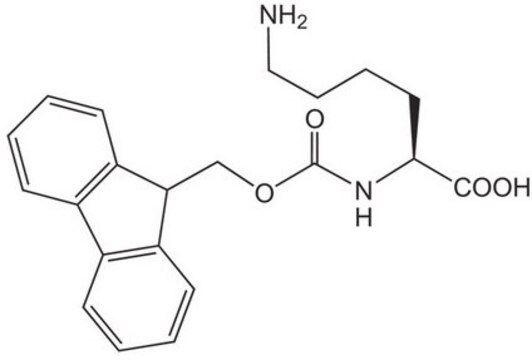おすすめの製品
アッセイ
>95% (HPLC)
形状
solid or viscous liquid
反応適合性
reaction type: Pegylations
ポリマー構造
shape: linear
functionality: homobifunctional
輸送温度
ambient
保管温度
−20°C
特徴および利点
Fmoc-N-amido-dPEG2-acid is a monodisperse PEG product that is useful for peptide synthesis. The ten-atom dPEG spacer allows the introduction of a short, hydrophilic spacer onto either end of a peptide chain or between two peptide chains. The flexible dPEG spacer conjugates to peptides using conventional peptide synthesis chemistry. Peptide PEGylation imparts water solubility to hydrophobic peptide chains. Also, PEGylated peptides have expanded hydrodynamic volumes, which can reduce or eliminate renal clearance, and are protected from proteolysis. The combination of decreased renal clearance and protection from proteolysis contributes to longer in vivo circulation times for PEGylated (as compared to non-PEGylated) peptides. Additionally, PEGylation diminishes a peptide′s antigenicity. This product is part of the Fmoc-N-amido-dPEGn-acid (n=2, 3, 4, 5, 6, 8, 12, 24, 36) product series.
法的情報
Products Protected under U.S. Patent #s 7,888,536 & 8,637,711 and European Patent #s 1,594,440 & 2,750,681
dPEG is a registered trademark of Quanta BioDesign
保管分類コード
11 - Combustible Solids
WGK
WGK 3
引火点(°F)
Not applicable
引火点(℃)
Not applicable
適用法令
試験研究用途を考慮した関連法令を主に挙げております。化学物質以外については、一部の情報のみ提供しています。 製品を安全かつ合法的に使用することは、使用者の義務です。最新情報により修正される場合があります。WEBの反映には時間を要することがあるため、適宜SDSをご参照ください。
Jan Code
QBD10243-1000MG:
最新バージョンのいずれかを選択してください:
Aaron S Anderson et al.
Langmuir : the ACS journal of surfaces and colloids, 24(5), 2240-2247 (2008-01-31)
We report a general procedure to prepare functional organic thin films for biological assays on oxide surfaces. Silica surfaces were functionalized by self-assembly of an amine-terminated silane film using both vapor- and solution-phase deposition of 3'-aminopropylmethyldiethoxysilane (APMDES). We found that
Ananda Kumar Kanduluru et al.
Bioconjugate chemistry, 27(9), 2157-2165 (2016-08-17)
The neurokinin-1 receptor (NK1R) is implicated in the growth and metastasis of many tumors, including cancers of the brain (e.g., gliomas, glioblastomas, and astrocytomas), skin (e.g., melanomas), and neuroendocrine tissues (cancers of the breast, stomach, pancreas, larynx, and colon). Because
Jered C Garrison et al.
Bioconjugate chemistry, 19(9), 1803-1812 (2008-08-21)
The high incidence of BB2 receptor (BB2r) expression in various cancers has prompted investigators to pursue the development of BB2r-targeted agents for diagnostic imaging, chemotherapy, and radiotherapy. Development of BB2r-targeted agents, based on the bombesin (BBN) peptide, has largely involved
Ian W Hamley
Biomacromolecules, 15(5), 1543-1559 (2014-04-12)
The remarkable diversity of the self-assembly behavior of PEG-peptides is reviewed, including self-assemblies formed by PEG-peptides with β-sheet and α-helical (coiled-coil) peptide sequences. The modes of self-assembly in solution and in the solid state are discussed. Additionally, applications in bionanotechnology
ライフサイエンス、有機合成、材料科学、クロマトグラフィー、分析など、あらゆる分野の研究に経験のあるメンバーがおります。.
製品に関するお問い合わせはこちら(テクニカルサービス)








